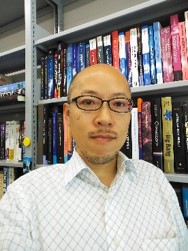
ページ読込中...

ページ読込中...

[English]
| 井上 昭雄 [教授] |  |
|
| homepage | https://www.obsap.phys.waseda.ac.jp/ | |
| 専門分野 | 観測宇宙物理学 | |
| 研究テーマ・研究活動 | ||
| 最遠方銀河、宇宙再電離、銀河形成進化、星間物理学、宇宙塵、惑星系形成1998年 京都大学理学部 卒業 2003年 京都大学大学院理学研究科 修了 博士(理学) 2004年 日本学術振興会海外特別研究員 フランス・マルセイユ天体物理学研究所 2005年 大阪産業大学教養部 講師 2008年 大阪産業大学教養部 准教授 2017年 大阪産業大学デザイン工学部 准教授 2019年 現職 |
||
アルマ望遠鏡、すばる望遠鏡や、ハッブル宇宙望遠鏡などの世界最先端の天文観測装置を駆使して、私たちが棲むこの宇宙の歴史、銀河の形成と進化のようすを解き明かすことを目指しています。
現在の宇宙の年齢は138億年と推定されています(図1参照)。その最初の10億年の間に、宇宙で最初の天体が生まれ、そして、大規模な星団である銀河が誕生したと理論的には予想されています。そのころの銀河を観測するのは、銀河がまだ小さく、また遠いために暗く、とても難しいのですが、アルマ望遠鏡を使って、なんとか今から約133億年前の銀河までは見つけることができました(2018年Nature誌に掲載、図2参照)。
また、その時代には、宇宙再電離が起こりました。これは、はじめ電離していた物質が、宇宙年齢約40万年ころにいったん中性になったのち、天体からの強い紫外線により、再び電離したという現象です。この宇宙再電離が、具体的にはどんな天体(銀河なのかブラックホールなのか)の紫外線で起こったのか、また、電離の進み方はどのようなものだったのか、などについても調べています。
ひるがえって、太陽系の近くにも興味深い天体が多数あります。例えば、発見ラッシュがつづいている太陽系外惑星が挙げられます。惑星系がどのように生まれるのかという研究も並行して行なっています。
| Akio Inoue [Professor] |  |
|
| homepage | https://www.obsap.phys.waseda.ac.jp/ | |
| research field | Observational astrophysics | |
| research keywords・career | ||
| Most distant galaxies, cosmic reionization, galaxy formation and evolution, interstellar physics, cosmic dust, planet formation1998 Kyoto University, Faculty of Science 2003 Kyoto University, Graduate School of Science, D.Sc. 2004 JSPS Post-doctoral fellow for research abroad at Laboratoire d’Astrophysique de Marseille 2005 Assistant professor at Osaka Sangyo University, College of General Education 2008 Associate professor at Osaka Sangyo University, College of General Education 2017 Associate professor at Osaka Sangyo University, Faculty of Design Technology 2019 Current position |
||
Using world’s cutting-edge astronomical facilities such as ALMA, Subaru and Hubble Space Telescope, I am working on the topics of the history of the Universe where we live and the formation and evolution of galaxies.
The current cosmic age is estimated at 13.8 billion years (Figure 1). During the first 1 billion years, the first objects and galaxies were expected to be formed theoretically. Observationally, it is difficult to find such objects because they are so faint due to the smallness and great distances. Fortunately, we discovered a galaxy at 13.3 billion light-years by using ALMA (published in Nature, 2018; Figure 2).
In the same era, cosmic reionization happened. This is a phenomenon that the matter in the Universe was ionized by strong ultraviolet radiation from astronomical objects
after it became once neutral at about 400 thousands years after the Big Bang when the matter was first ionized. I am exploring what kind of objects (galaxies or blackholes) actually ionized the Universe and how reionization proceeded.
In addition, there are also many interesting objects located in the Milky Way. For example, many discovery reports are coming up about extrasolar planets. I am also studying how such planetary systems form.